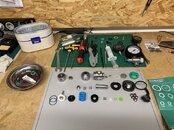I would be very curious to know specifically what the material is on the seat for the ‘nitrox’ kit. The whole nomenclature is deceptive, because any regulator is fine for nitrox up to 40%, and as far as I know SP specifically says the MK25 is not 100% O2 compatible. In other words, they are selling a rebuild kit that you don’t need for the named usage (nitrox) and aren’t supposed to use for your intended purpose. (100%O2).
If I’m wrong about that, someone can correct me.
I am currently in the process of setting up an O2 reg, and I have two choices; a MK10 and a MK2. I could also convert the MK10 to MK10+ and then use the MK25 ‘nitrox’ seat. I’m happy to share what I’ve learned so far if it’s helpful to anyone.
1. There is little doubt in my mind that the MK2 is theoretically the ‘safest’ of SP 1st stages for O2 use. SP does make an O2 compatible seat for it, and the seat is just a tiny plug. Other than that, there are 2 o-rings that are exposed to HP, the DIN seal and the HP port plug, or SPG o-ring. (Of course there’s also the o-ring that seals to the tank, but all regulators have that) So the MK 2 provides very little fuel for combustion. On the IP side you have 2 piston o-rings and port plugs/LP connections.
2. Since you’re breathing O2 at 20 ft or shallower, you don’t need anything like a high performance regulator. The MK2 is unbalanced but who cares in this situation. In fact, I’m pairing mine with a 108, also unbalanced, that has an orange exhaust tee and mouthpiece. I thought that was a nice touch, and even though it doesn’t matter, there’s very little plastic or rubber in the whole system.
3. I’m not giving up on the idea of using the MK10 for O2 either. The advantage for me is hose routing; it has a turret and that should help with keeping things very neat in storage, important for me as a cave diver, and since it’s a right angle regulator it will sit a little tighter against the smaller (40cft) bottle I’ll be using. There’s more potential fuel in the HP section, in addition to the seat and DIN seal, there’s a separate HP seat seal and the HP piston o-ring, plus an additional HP port. A total of 4 o-rings exposed to HP plus the larger seat. Converting to a MK10+ would presumably allow me to use the special O2 seat SP sells for the MK25, and I honestly have no idea how much of an improvement that seat would be. I don’t particularly trust the MK10+, as it’s known for IP creep and I’ll be leaving this bottle in a cave for a few hours on every dive. Of course the valve will be off, but if it creeps to the point of opening the 2nd stage, water could get in.
4. Here’s a question for anyone who wants to have a whack at it; someone mentioned to me that the knife edge pistons are not considered as safe for O2 use because the sharp edge can more easily heat up. I thought about this and decided it’s got be BS. Air doesn’t flow around the edge at HP, causing friction and heat. It expands around the piston edge, causing cooling. In fact, that spot is theoretically the coldest spot in the 1st stage, which is why piston regs are sometimes packed with grease in the ambient chamber to keep water away from the piston and freezing.
5. The MK10 still has less soft material in the HP section than the MK25 due to the bushings around the HP piston o-ring. And there’s the composite piston, which means a big chunk of plastic in the IP section. I have a pair of MK25s I use for sidemount but I would not choose one for O2 use. Maybe that goes against the common practice, and maybe it doesn’t even matter in the real world. As long as technique is good and the regulators are well cleaned, there’s probably very minimal risk.
6. One last bit to this endless post….I’m using Viton o-rings throughout the 1st stage, 90 duro on the HP side, 75 on the LP side. There is some controversy about this as the toxicity of burning viton is much worse than nitrile, but the combustion temperature is higher. Aviation does use nitrile (or at least used to) in 100% O2 settings. I know this because my old friend Couv (rip) was an aviation mechanic. I’m not crazy about viton as a seal but I figure I’ll be cleaning this reg often enough so that I’m not worried about the o-rings lasting for 5-10 years in use.




